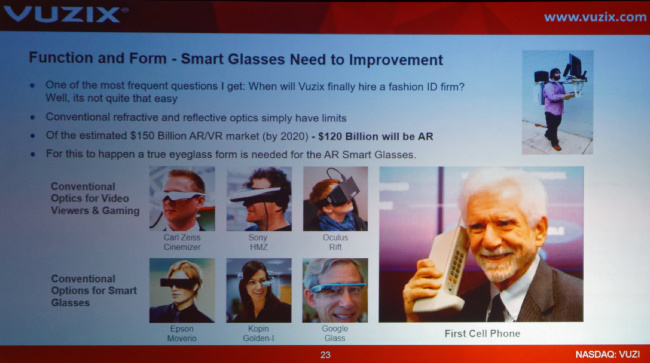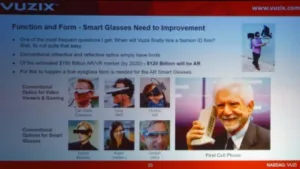 Paul Travers is the CEO of Vuzix which makes wearable displays and has been doing this for nearly 20 years. It has offices around the world. Until glasses get through the “Oakley gate” and are acceptable to users as a fashion item, they won’t be very widely adopted, but once you do that, the market will grow. Travers believes that once you get to that point, the market afterwards will be massive.
Paul Travers is the CEO of Vuzix which makes wearable displays and has been doing this for nearly 20 years. It has offices around the world. Until glasses get through the “Oakley gate” and are acceptable to users as a fashion item, they won’t be very widely adopted, but once you do that, the market will grow. Travers believes that once you get to that point, the market afterwards will be massive.
He doesn’t really see VR as the big application, but AR as the biggest long term one because you can connect with the real world. Because you can’t make glasses that look and feel like ‘Oakleys’, Vuzix is concentrating on professional applications.
The electronics in the Vuzix system is basically a smartphone with a camera. Travers described the system as an ‘AI-equipped partner’. It has sold more than 10,000 headsets and to 40 of the top 100 US companies.
The M300 is the next generation product and are glasses which are ‘light enough for an eight hour shift’. The glasses use an Atom processsor with Android 6.0 and ‘hot swap” batteries. The M3000 has new optics with optical waveguides and that makes them see-through.
DHL has used the glasses in warehouse picking – the glasses effectively becomes a hands-free barcode reader, replacing a hand held scanner and paper picking lists and Travers showed a video them being used by DHL Benelux. Vuzix is certified for use at Airbus and the error rates have been significantly reduced where assembly operators use the glasses.

At the moment, there are still too many challenges to deliver consumer applications, yet, because of the optics. Vuzix has designed a new waveguide optics system that can support FullHD and that may be in the market by the end of 2016 or 2017.

